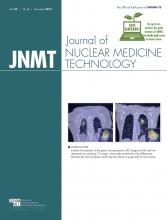A significant challenge for the Canadian nuclear medicine community is the single sourcing for most kits and ready-to-use radiopharmaceuticals. The main causes are the small size of the Canadian nuclear medicine market and intense competition from the other imaging modalities (MR imaging, CT, sonography). Another contributing factor is the frequent product shortages due to production problems, which eventually lead to product discontinuation. Alternatives are required that can provide the same image quality with similar costs and procedure times to ensure a seamless transition for nuclear medicine departments.
We set out to determine the significance of clinical and economic differences for a currently vulnerable procedure in Canada: in vitro red blood cell (RBC) labeling. Unquestionably, the in vitro method of labeling RBCs with 99mTc yields the highest labeling efficiency (1–3). This method should also be used for patients taking certain medications or who have previously been given contrast medium. However, not all available kits are fully reimbursed by the Canadian health insurance. Also, in December 2013, the only supplier of pyrophosphate kits in Canada—Mallinckrodt—withdrew the product from the market (4). We compared 3 Health Canada licensed kits (including pyrophosphate, which was still available at the time our comparison was performed) for the in vitro labeling method by exploring features such as labeled product quality and financial and practical differences.
Commercially available kits for UltraTag (Mallinckrodt), pyrophosphate (Mallinckrodt), and gluceptate (DraxImage) were used to label RBCs in vitro according to the manufacturer’s instructions and internal standard operating protocols, as summarized in Table 1. Heparin was used as an anticoagulant in all procedures. Labeling efficiency and cell viability were measured at 1, 2, 3, and 4 h after labeling at room temperature and at 37°C. Overall costs and the ease and duration of the procedure were also compared.
Procedures for In Vitro RBC Labeling
As expected, the highest labeling efficiencies were obtained using UltraTag (>98%) (5). Gluceptate and pyrophosphate kits yielded similar labeling efficiencies (94%–96%) (4,6). UltraTag-labeled RBCs also had the highest labeling efficiency over 4 h of stability testing both at room temperature and at 37°C (>95%). RBCs labeled using gluceptate or pyrophosphate showed a faster release of free 99mTc over time (92% at 4 h at room temperature and 89% at 37°C). Cell viability was consistently greater than 98% in all procedures at all time points. All products gave images of acceptable diagnostic quality (Supplemental Fig. 1, available at http://jnm.snmjournals.org) (4–6). UltraTag images had lower background than gluceptate and pyrophosphate images, as agrees with previous reports (2,5).
The main differences were in the preparation protocols and costs. First, in vitro RBC labeling methods requiring smaller volumes of blood are less cumbersome and require less time for both patient and technologist. UltraTag requires 1–4 mL of blood, whereas gluceptate and pyrophosphate require 10 mL of blood. This feature is valuable when dealing with difficult cases (2,5). Second, the UltraTag procedure is streamlined; few extraneous materials are required, unlike the centrifugation pretreatment–dependent process that gluceptate and pyrophosphate require. Third, UltraTag is the fastest labeling method; gluceptate and pyrophosphate RBC labeling require additional steps that generally double the labeling procedure time even in the most ideal circumstances. Nevertheless, there is a significantly higher cost for UltraTag than for gluceptate and pyrophosphate. UltraTag, which is not fully reimbursed through the Canadian health insurance, is the most expensive of the three, at $125 per vial. Alternatively, pyrophosphate costs about $80 per vial and each vial may be used for up to 2 patients. Gluceptate was the least expensive, at about $20 per vial. Thus, with pyrophosphate and gluceptate, one can expect lower costs with slightly decreased image quality but longer labeling times than with UltraTag.
All things considered, what is the bottom line? One may respond that the product with the highest product and image quality, the fastest procedure time, and the least patient discomfort should be the standard. However, in a managed care environment, where cost savings and outcomes are the primary indicators of product acceptance, this is not feasible in every case. For most studies without delay imaging and for most compliant patients, gluceptate is a reasonable choice in lieu of pyrophosphate, which is now available in Canada only through special access. Gluceptate kits are also single-sourced. UltraTag should be reserved for cases that require finer discrimination from background, such as low-rate gastrointestinal bleeding studies; for difficult patients such as children; and for urgent or unexpected cases. Therefore, for now, the best answer is the rule of thumb in health care: one must weigh the risks and benefits and make a case-by-case decision. Although the real price should be deduced not from the monetary cost of the procedure but from the benefits the procedure provides, this is not yet fully understood by some referring physicians and by the Canadian health insurance.
Many nuclear medicine procedures have disappeared over the last few years in Canada because of product unavailability. This situation will only worsen if the Canadian nuclear medicine community will not take a stronger stand on educating the public and Canadian health regulators on the advantages of nuclear medicine investigations. In terms of access to new drugs, Canada already ranks near the bottom of the member states of the Organization for Economic Co-operation and Development (7), and this is markedly reflected in the field of nuclear medicine.
Footnotes
Published online Nov. 11, 2014.
REFERENCES
- Received for publication September 17, 2014.
- Accepted for publication October 27, 2014.







